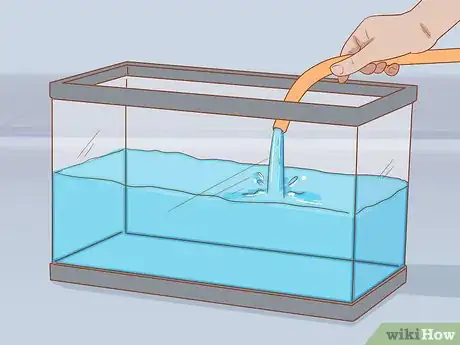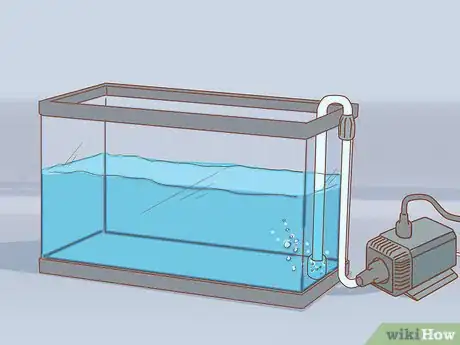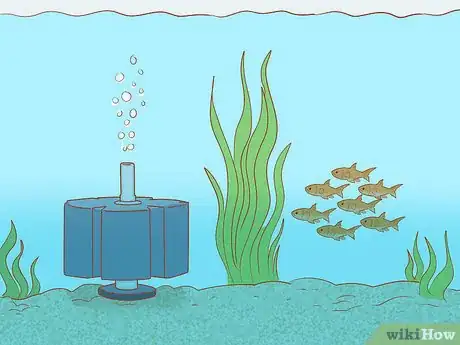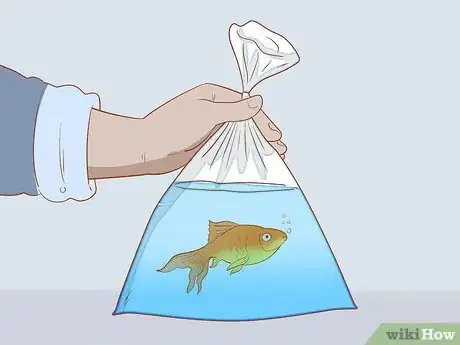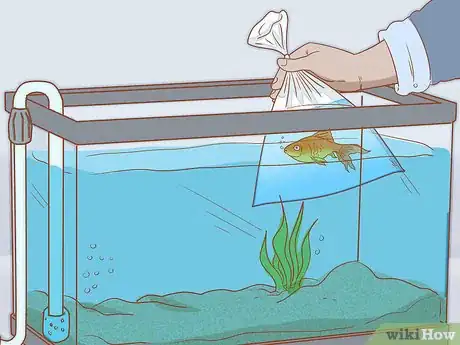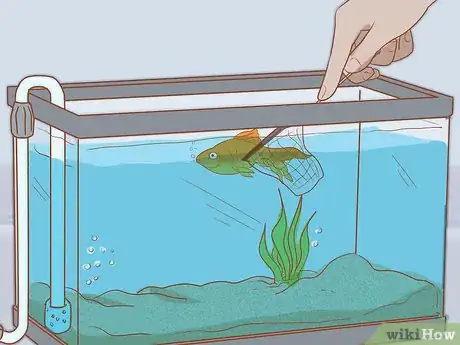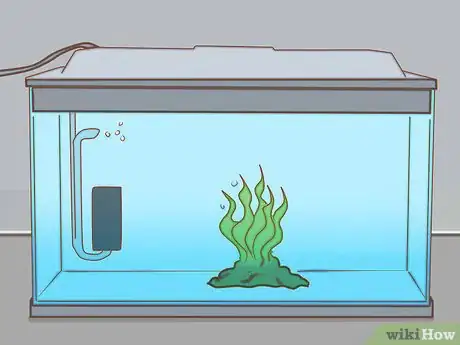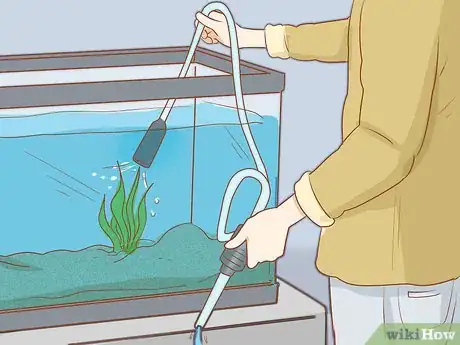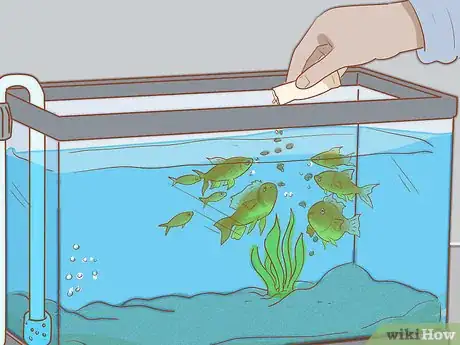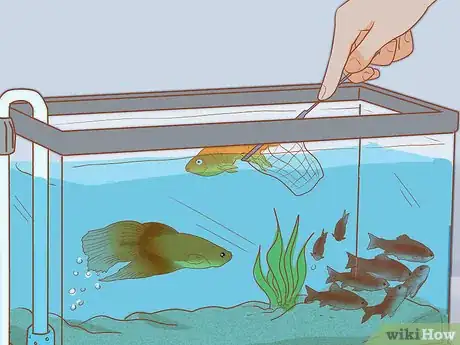This article was co-authored by Craig Morton. Craig Morton is the CEO of Aquarium Doctor Inc. based in Huntington Beach California and servicing Orange County, Los Angeles County, and the Inland Empire. With over 30 years of aquarium experience, Craig specializes in creating custom aquarium designs along with aquarium installation, service, and maintenance.
There are 8 references cited in this article, which can be found at the bottom of the page.
wikiHow marks an article as reader-approved once it receives enough positive feedback. In this case, several readers have written to tell us that this article was helpful to them, earning it our reader-approved status.
This article has been viewed 524,408 times.
Adding new fish to your tank can be an exciting time, as you can finally introduce new friends into your underwater environment. But many fish introduced into a tank improperly can get sick or die. You must first prepare the tank before adding them into your tank.[1]
Steps
Preparing the Tank
-
1Wash the gravel, rocks, and ornaments. Once you get your new tank and your tank additions, you will need to wash them in warm water. Do not use any soap or detergents to wash the gravel, rocks, or ornaments, just warm water. This will ensure these items are free of dirt, bacteria, and toxins.[2]
- You can wash the gravel by placing it in a colander. Put the colander over a plastic pan or bucket and add water to the colander with the gravel. Stir the gravel around, drain it, and repeat this several times until the water runs clear and clean through the colander.
- Once these items are clean, you can add them to the tank. Make sure the gravel is evenly distributed at the bottom of the tank. Place the rocks and ornaments in the tank so there are hiding places for your fish to explore.
-
2Fill the tank one-third full with room temperature water. Use a clean bucket to pour water into the tank. Place a plate or saucer over the gravel as you pour in the water so the gravel does not move around.[3]
- Once you have filled the tank one-third with room temperature water, you should add water conditioner or dechlorinator to remove the chlorine from your fish. Chlorine in the tank water can be deadly for your fish, and/or lead to health issues.
- You may notice that the water turns cloudy within the first two to three days. This is due to bacteria growth and should disappear naturally.
Advertisement -
3Connect the air pump. You should have an air pump in your tank to ensure there is enough oxygen in the tank water. You will need to connect the airline tubing from the air pump to air outlets in your tank, such as an air stone.[4]
- You may want to use an aquarium check valve, which is a small valve located outside your tank to hold the air tubing. This will allow you to then place the air pump underneath your tank or aquarium. The valve also acts as a stop and prevents water from backing up in your tank if somehow the power to the tank is switched off.
-
4Add live or plastic plants. Live plants are good for circulating oxygen in the tank water, but you can also add plastic plants to create hiding places for your fish. You can also use the plants to hide any equipment in the tank that you want to disguise for aesthetic purposes.[5]
- Keep the live plants moist until they are going to be planted by wrapping them in wet newspaper. Plant the roots below the surface of the gravel, with the crown of the plant exposed. You can also apply an aquatic plant fertilizer to make sure your live plants grow well.
-
5Cycle the water in the tank with a cycling kit. Cycling the tank water will help to balance out the ammonia and nitrites produced by the fish and introduce bacteria that will eat these harmful chemicals. You will need to cycle the tank water for four to six weeks so the tank can maintain a healthy biological and chemical balance. Doing this before adding the fish can help to ensure your new fish stay happy and healthy in their new environment. You can find cycling kits for aquariums at your local pet store or online.[6]
- When you first cycle the tank from scratch, you will notice a buildup of ammonia around the second or third week. Then, there will be a build of nitrites when the ammonia levels drop to zero. At around week six of cycling, the ammonia and nitrites will drop to zero and you will notice a buildup of nitrate. Nitrate is less toxic than ammonia and nitrite. You can control the level of nitrate with proper, regular maintenance of the tank water.
- If you use the cycling kit and notice there is still a positive reading for ammonia or nitrites, your tank is still cycling and will need more time to cycle before you add the fish. A healthy tank should never show a positive reading for either chemical.
-
6Test the water quality. Once the tank has been cycled properly, you should also test the water quality of the tank. You can use a water test kit from a pet store or online.
- The tank water should have a zero reading for chlorine and the pH of the water should match or be as close as possible to the fish shop where your new fish is coming from.
Adding Fish
-
1Transport the fish in a plastic bag from the store. Most pet stores put fish in a clear plastic bag filled with water. Make sure you keep the fish in a dark place as you transport him home from the store.[7]
- Try to get him home right away as he will need to be introduced to the tank soon after being placed in the plastic bag. This will reduce his levels of stress and help him acclimate faster to the tank water. Your fish may lose a little coloring during the trip home but don’t worry, this is normal and your fish should recover his coloring once he is in his tank.
-
2Turn off the lights in the aquarium. Dim or turn off any lights in the aquarium before you add your new fish, as this will create a less stressful environment for the fish. You should also make sure your tank has plenty of plants and rocks as hiding places for your new fish. These will help him feel less stressed out as he gets used to his new home.
-
3Add more than one fish at a time. Adding more than one fish at a time will ensure your existing fish can get used to the new additions. It also prevents one fish from getting harassed by the other fish, as the existing fish will have multiple new friends to bond with. Introduce new fish in small batches of 2-4 so you do not overwhelm the tank.[8]
- Always choose fish from the store that appear healthy and disease free. You should also carefully monitor your new arrival for the first several weeks to ensure there are no signs of disease or stress.
- Some aquarium owners will place their new fish in quarantine for two weeks to ensure he does not have any diseases or infections. If you have the luxury of time and access to another clean tank you can use as your quarantine tank, you can try this option. If you notice the fish gets sick in the quarantine tank, you can treat him without affecting the other fish or the chemistry of the new tank.
-
4Place the unopened plastic bag in the tank for 15-30 minutes.[9] Let the unopened plastic bag with the fish float on the surface of the aquarium. This will give the fish time to get used to the temperature of the tank water.[10]
- After 15-30 minutes, open the bag and use a clean cup to scoop an equal amount of water from the tank into the plastic bag. There should be twice as much water in the bag, 50% tank water and 50% pet store water. Make sure you do not mix the water from the bag into the tank water as this could contaminate the tank water.[11]
- Allow the bag to float in the tank for another 15-20 minutes. You can seal the edge of the bag to keep in from spilling out.
-
5Net the fish out of the bag and place him in the tank. After 15-20 minutes, release the fish into the tank. Do this by netting the fish in the bag and gently placing them into the water of the aquarium.[12]
- You should monitor the fish for any signs of disease or illness. If there are already other fish in the tank, you should make sure they are not harassing or bothering the new addition. With time and proper maintenance of the tank, all the fish should co-exist happily.
Putting Fish into an Existing Tank
-
1Set up a quarantine tank. Quarantining your new fish will ensure they are healthy and will not introduce disease or illness into your existing tank. The quarantine tank should be at least 5 to 10 gallons, with a sponge filter that has been in a tank with fish. This will ensure the filter contains good bacteria to populate the tank. The tank should also have a heater, an aquarium light, and a cover.[13] [14]
- If you are an avid aquarium owner, you may already have a quarantine tank set up. You should keep the quarantine tank clean and prepare it before you buy new fish for your regular tank.
-
2Place the new fish in the quarantine tank for two to three weeks. Once you get your quarantine tank set up, you can introduce your new fish to the tank through acclimatization.[15]
- Start by placing the unopened plastic bag in the tank for 15-20 minutes. This will give the fish time to start getting used to the water in the quarantine tank.
- After 15-20 minutes, open the bag and use a clean cup to scoop an equal amount of water from the tank into the plastic bag. There should be 50% tank water and 50% pet store water in the bag. Avoid mixing water from the bag with the tank water as this could contaminate the tank water.
- Allow the bag to float in the tank for another 15-20 minutes. You can close the edge of the bag to keep in from spilling out. After 15-20 minutes, use a net to gently scoop out the fish and place them in the quarantine tank.
- You should observe the fish every day in the quarantine tank to ensure they are not carrying any disease or parasites. After two to three weeks in the quarantine tank with no issues, the fish is ready to be introduced to the main tank.
-
3Do a 25 to 30 percent water change. Doing a water change will allow your new fish to get used to the nitrates in the water and avoid stressing out your new fish. This is an especially important step if you do not do regular water changes of your main tank water.[16]
- To do a 25 to 30 percent water change, remove 25 to 30 percent of the tank water and replace it with dechlorinated water. Then, cycle through the water several times with your filter to ensure the nitrate balance in the tank water is correct.
-
4Feed any fish in the main tank. If you already have fish in your tank and are introducing a new fish to the tank, you should make sure you feed the fish first. This will make the fish in the tank less aggressive towards the new addition.
-
5Rearrange the accessories in the tank. Move around any rocks, plants, and hiding places in the tank to new spots. Rearranging the accessories before you introduce the new fish will distract the existing fish and remove any established territories that have been marked in the tank. This will ensure your new fish enter the tank on equal grounds and are not isolated from the other fish.[17]
-
6Acclimatize the new fish to the main tank water. Once your new fish have been properly quarantined, you should repeat the same acclimatization process you did with the quarantine tank for the main tank water. This will help the fish get used to the main tank water and ease into their new environment.[18]
- Place the fish in a bowl or bag filled with the quarantine tank water. Let the bag or bowl sit on the surface of the main tank water for 15-20 minutes. Then, use a clean cup to scoop some of the main tank water into the bag or bowl. There should be 50% main tank water and 50% quarantine tank water in the bag.
-
7Introduce the new fish into the main tank. Let your fish sit in the bag or bowl of water for another 15-20 minutes. Then, use a net to gently scoop the fish out of the bag or bowl and place him in the main tank.[19]
- Monitor the new fish over the next few weeks to ensure he is getting along with his tank mates and is not displaying any signs of illness or disease.
Expert Q&A
Did you know you can get expert answers for this article?
Unlock expert answers by supporting wikiHow
-
QuestionCan you add fish to a new tank right away?
 Craig MortonCraig Morton is the CEO of Aquarium Doctor Inc. based in Huntington Beach California and servicing Orange County, Los Angeles County, and the Inland Empire. With over 30 years of aquarium experience, Craig specializes in creating custom aquarium designs along with aquarium installation, service, and maintenance.
Craig MortonCraig Morton is the CEO of Aquarium Doctor Inc. based in Huntington Beach California and servicing Orange County, Los Angeles County, and the Inland Empire. With over 30 years of aquarium experience, Craig specializes in creating custom aquarium designs along with aquarium installation, service, and maintenance.
Aquarium Specialist, Aquarium Doctor Inc.
-
QuestionWhat temperature is good for tropical fish?
 Community Answer75-80 degrees is the recommended temperature for most tropical fish.
Community Answer75-80 degrees is the recommended temperature for most tropical fish. -
QuestionHow soon should I feed my new betta?
 Community AnswerGive him at least 12 hours after getting him, then you can start feeding him. Make sure you have the right food and you aren't giving him too much.
Community AnswerGive him at least 12 hours after getting him, then you can start feeding him. Make sure you have the right food and you aren't giving him too much.
References
- ↑ Craig Morton. Aquarium Specialist, Aquarium Doctor Inc.. Expert Interview. 21 July 2020.
- ↑ http://www.tetra-fish.com/aquarium-information/how-to-set-up-an-aquarium-fish-tank-setup.aspx
- ↑ http://www.tetra-fish.com/aquarium-information/how-to-set-up-an-aquarium-fish-tank-setup.aspx
- ↑ http://www.tetra-fish.com/aquarium-information/how-to-set-up-an-aquarium-fish-tank-setup.aspx
- ↑ http://www.tetra-fish.com/aquarium-information/how-to-set-up-an-aquarium-fish-tank-setup.aspx
- ↑ http://noahsark.bm/blog/38695/steps-to-take-before-adding-fish-to-a-new-tank
- ↑ http://www.firsttankguide.net/introduce.php
- ↑ http://www.liveaquaria.com/PIC/article.cfm?aid=170
- ↑ Craig Morton. Aquarium Specialist, Aquarium Doctor Inc.. Expert Interview. 21 July 2020.
- ↑ Craig Morton. Aquarium Specialist, Aquarium Doctor Inc.. Expert Interview. 21 July 2020.
- ↑ Craig Morton. Aquarium Specialist, Aquarium Doctor Inc.. Expert Interview. 21 July 2020.
- ↑ http://fins.actwin.com/mirror/begin-addfish.html
- ↑ http://www.fishchannel.com/fishkidz/beginner-fish/acclimating-new-aquarium-fish.aspx
- ↑ http://www.streetdirectory.com/travel_guide/30654/pets/how_to_properly_introduce_new_fish_into_your_aquarium.html
- ↑ http://www.fishchannel.com/fishkidz/beginner-fish/acclimating-new-aquarium-fish.aspx
- ↑ http://www.fishchannel.com/fishkidz/beginner-fish/acclimating-new-aquarium-fish.aspx
- ↑ http://www.liveaquaria.com/PIC/article.cfm?aid=170
- ↑ http://www.fishchannel.com/fishkidz/beginner-fish/acclimating-new-aquarium-fish.aspx
- ↑ http://www.fishchannel.com/fishkidz/beginner-fish/acclimating-new-aquarium-fish.aspx
About This Article
To add fish to a new tank, begin by turning off the lights in the aquarium to create a calm environment for the fish. Next, scoop some of the tank water into the bag with the fish in it. Then, let the bag float in the tank for a few minutes to give the fish time to get used to the new tank temperature. After 20 minutes, net each fish to remove it from the bag and transfer it into the tank. For tips from our Veterinary reviewer on adding fish to an existing tank with other fish, read on!


